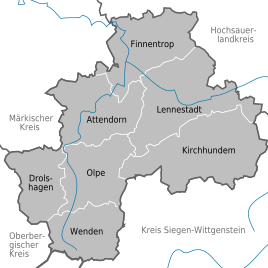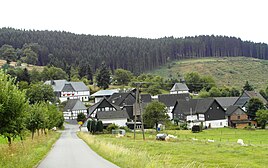Ramscheid (Finnentrop)
|
Ramscheid
Finnentrop municipality
Coordinates: 51 ° 12 ′ 21 ″ N , 8 ° 5 ′ 6 ″ E
|
||
|---|---|---|
| Height : | 387 m above sea level NHN | |
| Residents : | 34 (Dec 31, 2016) | |
| Postal code : | 57413 | |
| Area code : | 02724 | |
|
Location of Ramscheid in the district of Olpe |
||
|
View of Ramscheid from the Serkenrode driveway
|
||
Ramscheid is a place in the municipality of Finnentrop in the district of Olpe , North Rhine-Westphalia in the southern part of the Sauerland with around 30 inhabitants. Ramscheid lies at about 390 m. ü. NN.
history
Origin of the place name
Documented references to the existence of the place go back to the 14th century. Examples are: 1313: Rambesbike, 1338: in Ramesbeke in parochia Slipruden, 1565: Rammeßbecke, from 1655/57 change of the name to the ending "-schede": Holthofer zu Rambschede (in a ten-solution register ). Based on the basic word "-bike / -beke" as a reference to a body of water (or a brook) and its connection to the Middle Low German "ramese" for wild garlic, Floer believes the place name is interpreted as "a brook whose surroundings are overgrown with wild garlic" , for likely.
The historic courtyards
Politically, Ramscheid belonged to the domain of the Werler Counts , from whom the Counts of Arnsberg emerged after moving to Arnsberg in the 11th century . In 1368 the archbishops of Cologne became their legal successors.
The early development of Ramscheid is characterized by the four farms Holthof , Japes , Sievert and Volmer . In accordance with the aforementioned political conditions, it was a question of the Counts of the Arnsberg, later of the Archbishopric of Cologne, and then of free farms.
At the time of the Arnsberg Counts in the 14th century, the knight families v. Elsepe (Elspe) and v. Dusentschuren (Dünschede). These families also play a role in the history of Elspe and Dünschede . In detail, the Counts of Arnsberg enfeoffed the Heydenricus de Dusentschuren with a Ramscheider court and Herbordus de Elsepe with another court . These are the farms that later fell into the hands of the Sievert and Japes farmers in the 15th century.
The first fief that is known for the Holthof (considered to be the most important of the Ramscheider courtyards) was pronounced in 1371 by the Archbishop of Cologne for Antonius de (= von) Ramesbecke (wording in the translation: “Antonius von Ramesbeke has the main courtyard received in Ramesbeke in the parish Schliprüthen and has been enfeoffed with it out of special grace. "). The name "Holthof" does not appear in this wording, the first Holhöfer also called themselves based on the place name "von Ramesbeke".
In the course of further history the farms in Ramscheid became free property of the farming farmers. Details are not documented in detail. However, it is known that the cramped economic circumstances of feudal lords, which led to the sale of feudal goods, were not isolated cases.
But there was also an asset-based tax liability for goods that had become free, e.g. B. to finance the judiciary and the churches. From the tax rates that are known for Ramscheid from the 16th century, it can be concluded that the Holthof was a comparatively large farm. The tax rates were z. B. for the year 1543 for the Holthof 5 gold gulden , for Japes 2.5 gold gulden, for Sievert also 2.5 gold gulden and for Volmer 1 gold gulden.
Others
The place, located in a wooded and hilly landscape, currently has 33 inhabitants and has retained its rural character to the present day. There is a wood processing company with 16 employees, whereby the names of the owners point to descendants of the aforementioned main farm in Ramscheid. A non-profit association has converted an old farmhouse in Ramscheid into a country school home with leisure activities. There is a chapel built in the 17th century that is dedicated to St. Agatha . An old railway line that was redesigned as a section of the Sauerland cycle ring runs right past the village .
See also
literature
- Willi Voss: The Holthof in Ramscheid. Digitized version (PDF; 230 kB)
Individual evidence
- ↑ Population statistics of the municipality of Finnentrop (as of December 31, 2016). (PDF) Municipality of Finnentrop, accessed on May 16, 2017 .
- ↑ see in detail Flöer, Michael, Die Ortsnames des Kreis Olpe, Westfälisches Ortsnamenbuch (WOB), Bielefeld: Verlag für Regionalgeschichte 2014, pp. 194,195
- ↑ Information from the municipality of Finnentrop


